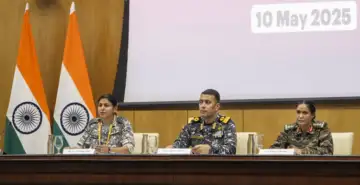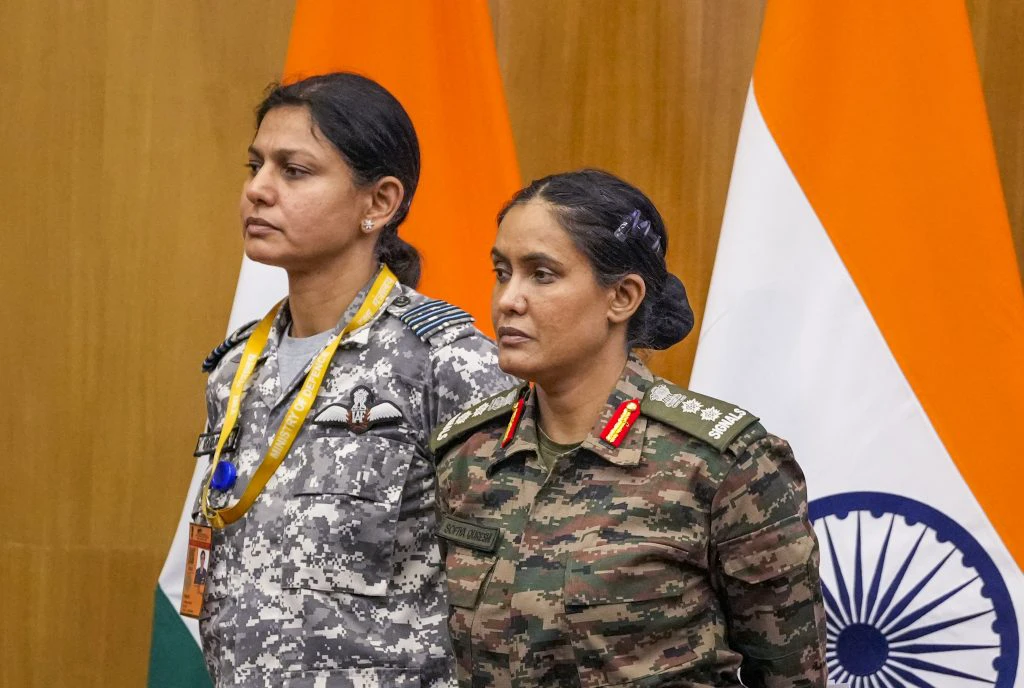Reiterating India’s firm stance regarding safeguarding its territorial integrity, three important official statements were made earlier this month, all within a span of 96 hours.
First, defence minister Rajnath Singh warned Pakistan that any misadventure in the Sir Creek area would invite a severe Indian response that could “change both history and geography”.
Echoing the same sentiment, India’s army chief, General Upendra Dwivedi, warned that Pakistan would have to choose between ‘remaining in geography or becoming history’ if it attempts any new hostility.
And then, the Chief of Air Staff repeated – and amplified – his earlier claim of the IAF having inflicted heavy losses on Pakistan during Op Sindoor, saying that it ‘took out over a dozen aircraft – 4-5 fighter jets of F-16 and JF-17 class, one surveillance aircraft in the air and other military infrastructure.’
In response to these statements, Pakistan was quick to come up with its usual response, warning about the threat of nuclear war – a bluff called out multiple times by India.
Earlier, Prime Minister Narendra Modi, while addressing the nation after the horrific attack in Pahalgam on innocent civilians, had said that the perpetrators of the heinous act and their handlers would be brought to justice.
In spite of the Indian government being very clear about its intent and directions, and in spite of the Indian armed forces executing strikes in a coordinated and calibrated manner on terrorist or military infrastructure deep inside Pakistan, many analysts and commentators are pre-occupied with only one aspect – India’s failure to sell its narrative to a world preoccupied with the nature and extent of Indian air losses – while ignoring the larger strategic message that has been delivered. That an act of terror will henceforth be seen as an act of war and that retribution will be there in strongest measure at the place and time of our choosing.
It’s simply a case of missing the woods for the trees while airing views on information warfare.
Strategic intent
Pakistan might have briefly managed control of information space with fictional stories and doctored content but India’s message both on the battlefield and digital space (strategic message/communication) was absolutely loud and clear.
The prime minister’s statement with respect to the perpetrators of terror and their handlers being brought to justice was the narrative, clearly displaying India’s threshold of tolerance, which required no further amplification. In short order, India’s leadership, both political and military, walked the talk.
Conflict is a serious proposition. While a simple lie might temporarily triumph over a complex truth, let’s not forget that in the larger context truth alone prevails. Therefore, it’s not about being the fastest finger first but about beingcredible and consistent. After all, it’s a nation’s credibility at stake, which sadly is missing in the adversary’s case.
Strategic messaging is not about the instant domination of information space but about conveying the intent. So from Pulwama to Pahalgam, India has always not only reiterated but also demonstrated its ability to thwart Pakistan’s designs by hitting them hard and decisively with a ‘Whole of Nation’ approach in the entire diplomatic, information, military and economic spectrum. From strategic planning to kinetic execution, all available options were effectivelyexercised in a graduated response.
Modus operandi
Effective perception management hinges on a clearly identified target audience and a well-defined end state. Therefore, in any situation, clarity of intent will decide the content of messaging, which in turn projects the intent and collectively facilitates delivery of the message to both global and domestic audiences.
While the adversary focused on peddling fake news without accountability, India was committed to evidence-based, coherent, credible and impactful messaging.
Having learnt their lessons well from previous operations, the Indian information sharing apparatus worked tirelessly in absolute synergy to provide multi-modal, timely updates to expose Pakistan and its military during daily formal/ informal briefings.
An analysis of the military’s PR mechanism, particularly the additional directorate of strategic communication (ADGSC), clearly demonstrates their ability to disseminate multiple channel, fact based, near real time information to shape perceptions.
Within an hour and a half of the commencement of Op Sindoor,social media posts and press releases giving initial details set the narrative. This was corroborated by sharing video evidence of the operation, followed by a detailed joint press conference by the Indian foreign secretary and representatives of thearmed forces to shape the information environment. Daily briefings with skilfully packaged messages andstrong visual content helped bridge the information vacuum and counter the adversary’s disinformation campaign.
 File image: From left, Wing Commander Vyomika Singh, Cmde. Raghu R Nair, NM and Colonel Sofiya Qureshi during a special briefing on Operation Sindoor, in New Delhi, Saturday, May 10, 2025. Photo: PTI Photo/Ravi Choudhary.
File image: From left, Wing Commander Vyomika Singh, Cmde. Raghu R Nair, NM and Colonel Sofiya Qureshi during a special briefing on Operation Sindoor, in New Delhi, Saturday, May 10, 2025. Photo: PTI Photo/Ravi Choudhary.
Road ahead
The army chief has compared Op Sindoor to playing a game of chess as ‘we did not know what would be the enemy’s next move’ . He further said that ‘though the test match stopped on the fourth day’ it could have been a protracted conflict.
These analogies clearly emphasise the intricacies of narrative management during conflict.
India did exceptionally well to expose the adversary – from presenting video evidence of damage inflicted on the terror infrastructure, theirmilitary’s top brass attending funeral prayers of terrorists, exposing the military’s patronage and support in aiding and abetting various terrorist groups and calling their bluff on various issues.
However, this is still work in progress. There’s a need to further strengthen the institutionalised approach to proactively counter adverse narratives in cyber, electronic and information space for effectively shaping one’s own narrative and to counter adverse perceptions. This must also necessarily involve countering fake news which exaggerates the scale and successes of India’s military action. Irresponsible claims made by Indian TV channels that India had destroyed Karachi Port, or that Indian soldiers had crossed the land border, ought to have been quickly countered with the facts.
It’s also time to consider establishing centres of excellence with military – private partnerships, engaging influencers and actively harnessing the potential of the diaspora’s network to push India’s narrative.
While we’re being subjected to a 24×7 disinformation campaign from unknown/ anonymous social media interlocutors, it is better to be vigilant and buckle up.
Rajesh Kalia, a former Colonel in the Indian Army, served as Defence Public Relations Officer in the 3&4 Corps and 14&15 Corps of the Indian Army. His operational background includes service in Siachen, Jammu and Kashmir and Sri Lanka (as part of the Indian Peace Keeping Force). He retired in January 2025.
